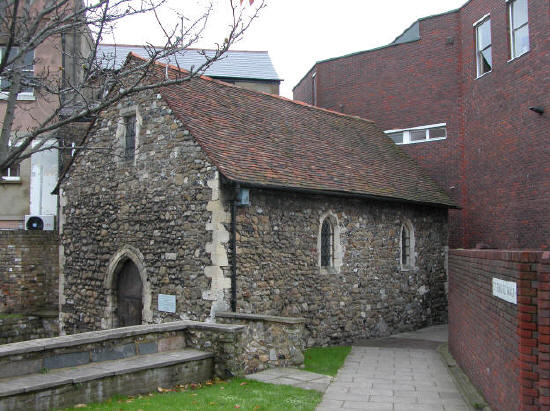| Back |
St Edmund's Chapel |
|
|
|
|
The Chapel of St Edmund was the first and only chapel ever dedicated by an English saint to an English saint. It was also the first chapel to be dedicated to St Edmund of Abingdon, who was Archbishop of Canterbury from 1234 to 1240. Bishop Richard of Chichester was appointed by the Pope to preach the seventh crusade, and by the royal council to collect funds. In 1253, while on a journey through Sussex and Kent on this task, worn out by his travels and his strict lifestyle, Richard was taken ill. He had accepted the invitation of the brothers of the Maison Dieu to consecrate a chapel in the cemetery they had provided for the burial of the poor, and on Sunday 30 March he consecrated it in honour of the Archbishop. It was to be his last act as bishop. The next day he was taken
ill at Morning Prayer, and four days later, in the night of 2–3 April, he
died in the Maison Dieu. The Chapel was surrendered by the Master and Brethren to King Henry VIII, along with the Maison Dieu and all its other property, on 11th December 1544. Over the following centuries, other buildings were erected all round it and the chapel was forgotten until 1883. When re-discovered in 1884, the remains were described in a paper read by Mr E. P. Loftus Brock, F.S.A., Hon. Secretary of the British Archaeological Society.
It was once more revealed when enemy shells destroyed two of the shops in Priory Road on 24th August 1943. The ruins were cleared and a small garden was created in front of the chapel. It is known that, after Mr. Loftus Brock visited in 1883, Frederick Turtle, a whitesmith, plumber and electrician, had the premises for his workshop. Later, Mr. G. Isaacson, another whitesmith, had his workshop there. Around 1945, the chapel was taken over by the Buckland branch of the Toc H. They had their meeting room upstairs and used the downstairs as a workshop where they chopped and sawed wood for distribution as firewood to the elderly, and made and repaired toys as Christmas presents for poor children. In 1944, the Borough Engineer, Mr. Philip Marchant, proposed to restore the chapel as part of the re-building of the town after the war. The proposal was to preserve the chapel in "a strip of lawns and gardens fronting Biggin Street." He also proposed moving the war memorial from its original position in front of Maison Dieu House to the lawns surrounding the chapel, making the whole into a memorial for the dead of the two World Wars. Another suggestion to preserve the chapel was made in a letter to the Kent Messenger in 1963, but it was not until Father Terence Tanner, of St Paul's, purchased the building and the site of the two shelled buildings adjoining in 1965 that restoration began. The work commenced on 16th November 1966 and the chapel was re-consecrated on 27th May 1968 by Archbishop Cowderoy of Southwark. At just 375 square feet, it is claimed to be the smallest church in regular use in England. The total cost of purchasing and restoring the chapel and its surroundings was approximately £11,000. The cost was met by subscription from about 1,300 people; the Patron of the appeal was the Prime Minister, Mr. Harold Macmillan. The chapel is now owned and maintained by the Saint Edmund of Abingdon Memorial Trust. |
|
|
(Information from "Saint Edmund's Chapel Dover and its Restoration", by Father Terence Tanner; the Diocese of Chichester website; and from the information board outside the chapel) |
